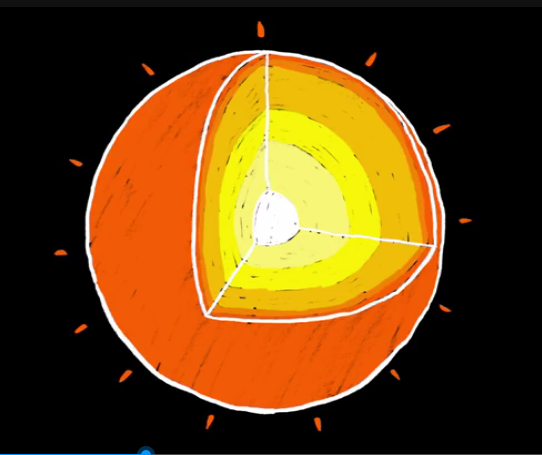From this photo it’s easy to see that not all parts of a flame are made the same – they can be brighter around the edges and darker in the middle.
从这张照片很容易看出,火焰的各个部分是不一样的——边缘处更亮,中间更暗。
Which is weird, because a flame is normally brightest in the middle, since that’s where you’re looking at the most hot burning gas.
这很奇怪,因为火焰通常中间最亮,因为中间才是你看到的温度最高的燃烧气体。
I mean, look at the sun – actually, don’t do that without a solar filter – but, it’s a big ball of hot glowing gas, and it’s definitely brightest in the middle.
我的意思是,看看太阳——实际上,不要忘了通过太阳滤镜去看——但是,它是一个由炽热的气体组成的大球体,而且它中间绝对是最亮的。
In fact, not only does it get darker towards the edges, it gets redder.
事实上,它不仅在边缘处变暗,而且会变红。
These dark, red edges of the sun are called “limbs,” since “limbus” is latin for “edge”.
这些太阳暗而红的边缘被称为“limbs”,因为“limbus”在拉丁语中是“边缘”的意思。
And the limbs of the sun get darker and redder near the edge for three simple reasons:
太阳的边缘部分会变黑变红,有三个简单的原因:
First, the sun is cooler closer to its “surface” and hotter deeper in.
首先,太阳“表面”温度较低,中心温度高。
Second, hotter stuff glows brighter and yellower, which you’ve probably seen with a hot poker or candle flame.
第二,更热的东西会发出更亮和更黄的光,你大概在红的火钳或蜡烛的火焰中见过这种现象。
And third, if you look across the edge of a sphere, you have to look through more of the sphere for your line of sight to reach a given depth than when you look directly into the middle.
第三,如果你从球体的边缘看过去,要想看到某个特定的深度,你的视线要比正中间看过去经过的范围更大。

If the sphere is only partially transparent (like the sun), when looking at the edge, you won’t see as deep into the depths before your vision is blocked.
如果球体只有部分透明(像太阳一样),当你看边缘时,在你的视线被阻挡之前,你不会看到那么深。
So, when you look directly – through a solar filter – into the middle of the sun, you see deeper in to hot gas which glows bright and yellow.
所以,当你通过太阳滤镜直接看太阳中央时,你会看到太阳深处炽热的气体发出明亮的黄色光芒。
And when you look at the edge of the sun, you see shallower, cooler gas which glows darker and redder.
当你观察太阳的边缘时,你会看到更浅、更冷的气体,它们发出更暗更红的光。
The same effect in reverse explains why some flames have bright edges and darker centers –
同样的效果反过来解释了为什么一些火焰有明亮的边缘和较暗的中心——
these flames are clearly hotter and brighter near their surfaces, likely because that’s where the best mixture of oxygen and fuel is,
这些火焰在靠近其表面的地方明显更热更亮,很可能是因为那里是氧气和燃料的最佳混合处,
so when we look at their edges, our line of sight passes through more hot light-emitting gases than when we look straight-on.
所以当我们看它们的边缘时,我们的视线穿过的热发光气体比我们看正前方时要多。
Take a candelabra and turn it side-on, and you’ll see exactly what’s going on.
拿一个大烛台,把它翻过来,你就能清楚地看到发生了什么。
The optical effect I describe in the video is called limb darkening or limb brightening.
我在视频中描述的光学效应被称为“临边昏暗”或“临边增亮”。
It also explains the theory the ring-like appearance observe nebulae which are actually hollow expanding shell of glowing gases.
这也就解释了环状的观测星云实际上是膨胀的炽热气体的外壳。











